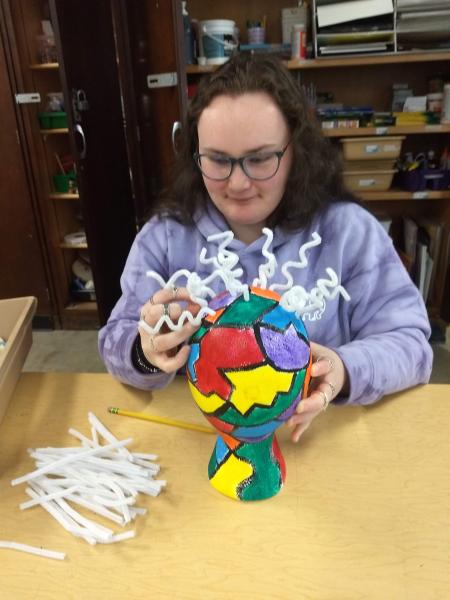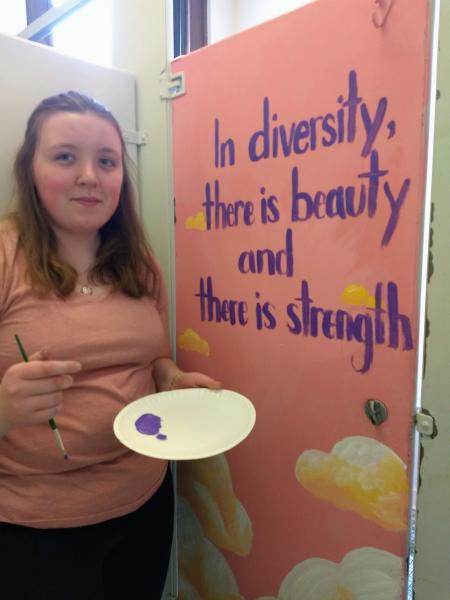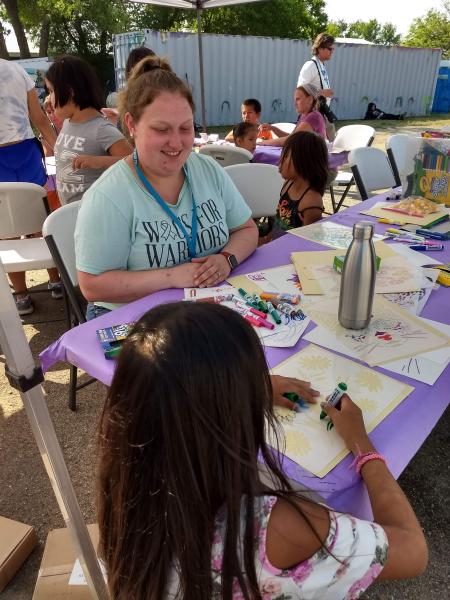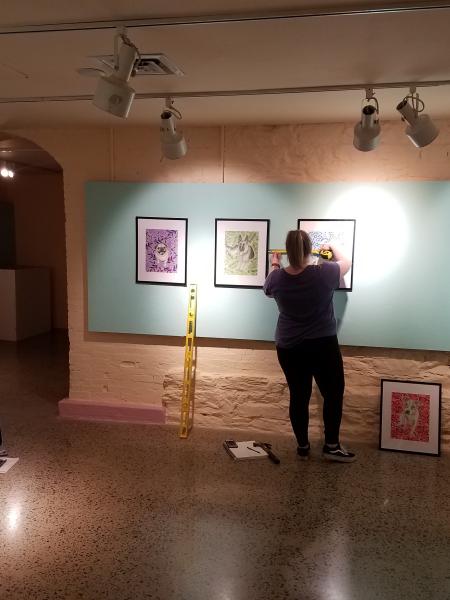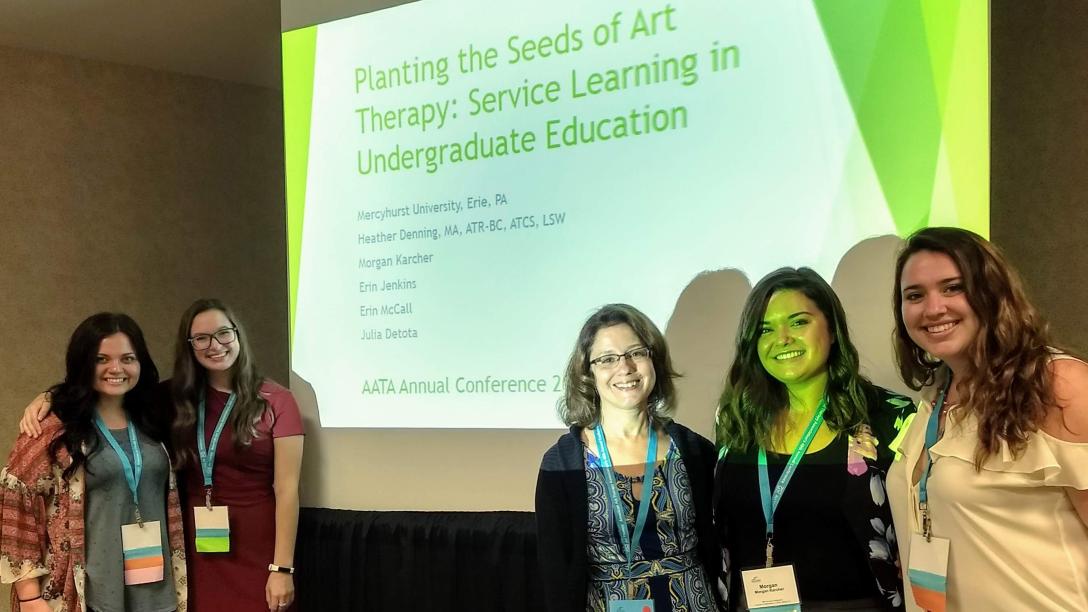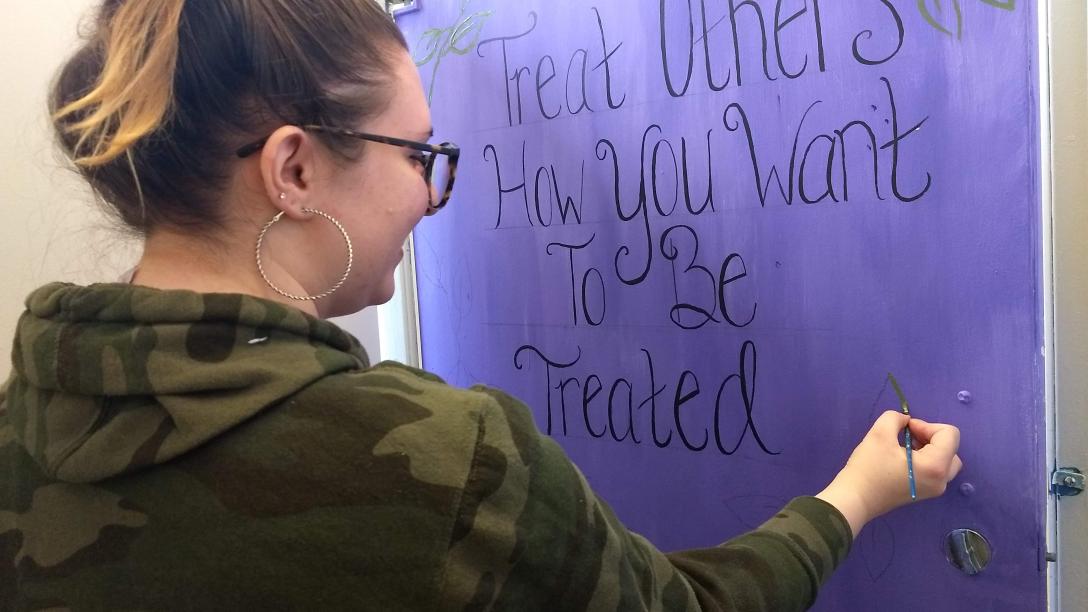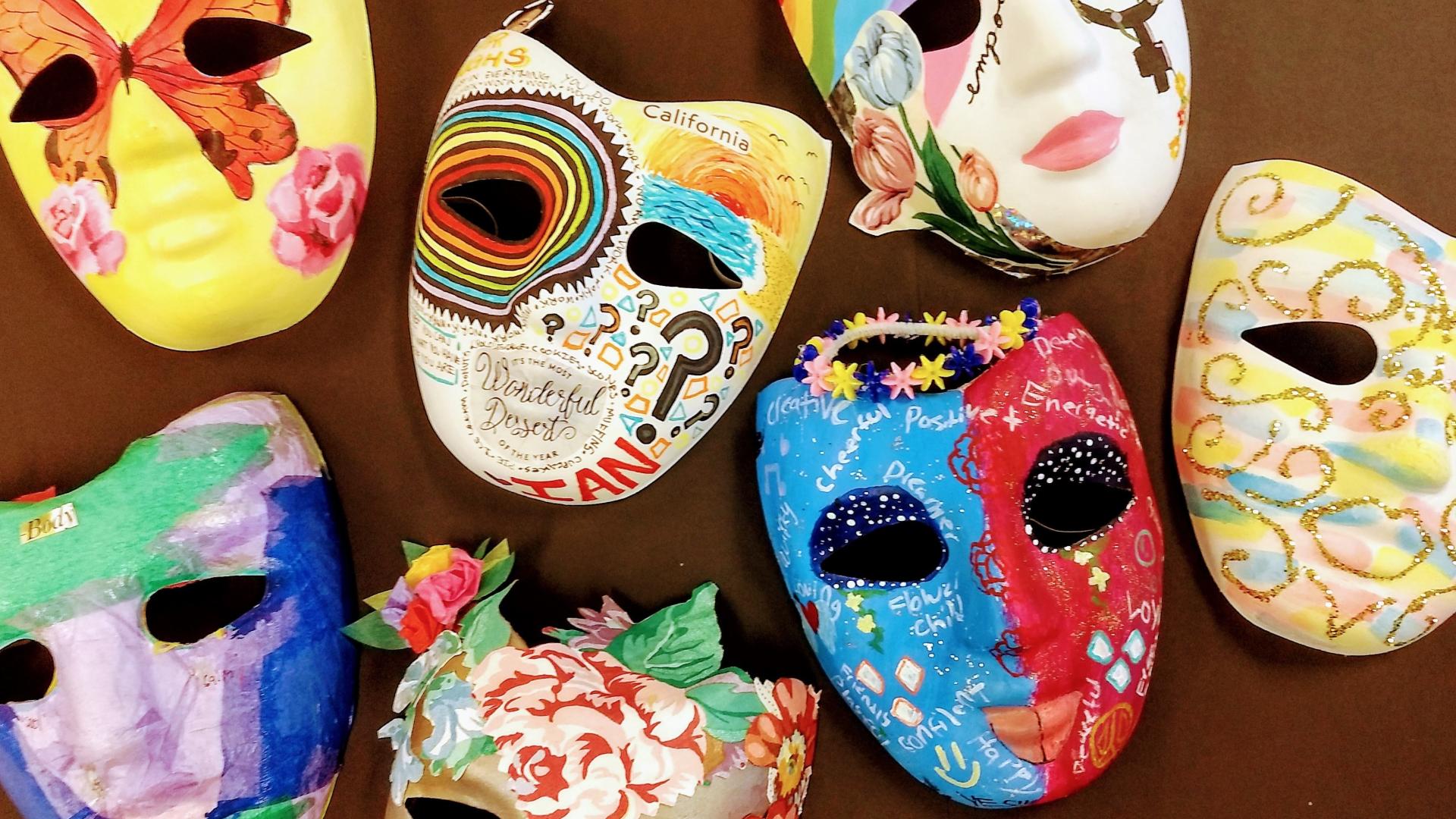
Art Therapy
Art Therapy majors at Mercyhurst investigate the healing potential of the arts through self-reflective art directives, research and service learning in the community. In art therapy classes, students experience the healing nature of art making during discussions that focus on the history and development of the field, the therapeutic use of art media, and ways to help others through art. Students’ development of a non-judgmental approach toward art made by themselves and others enables an ability to support the use of art as a way to promote creativity and wellness. Graduates of the program often work in the human service field or pursue graduate school for art therapy.
Fast Facts
- In 2016, Mercyhurst’s program was ranked as one of the top undergraduate art therapy programs in the nation, according to Best Counseling Degrees, making Mercyhurst’s the only program in Erie County to be recognized.
- Students have the opportunity to travel abroad and volunteer in art therapy related service learning experiences.
- The Mercyhurst Art Therapy Club allows majors to get to know each other outside of classes and get involved in campus activities.
- Students are required to take courses in art, art therapy, psychology, and sociology, building the abilities needed to support the use of art as a way to help others.
- Focus solely on Art Therapy or add an additional major or minor in related art programs such as Art Education, Photography, Graphic Design or Studio Art.
- Students have the opportunity and have presented at regional and national art therapy conferences supporting professional development.
- ACCT 101: Principles of Accounting (Three credits)
- MGMT 120: Principles of Management (Three credits)
- MKTG 162: Principles of Marketing (Three credits)
- DANC 200: Introduction to Arts Administration (Three credits)
- DANC 475: Arts Management Internship (Three credits)
- ART 128: Graphic Design Basics (Three credits)
- COM 240: Digital Video Production (Three credits)
- COM 260: Introduction to Social Media (Three credits)
- ART 321: Introduction to Website Design (Three credits)
- COM 312: Communication & Social Responsibility (Three credits)
- COM 314: Global Communications (Three credits)
- COM 330: Web & Social Media Analytics & Strategies (Three credits) Requires COM 260 to be taken previously or concurrently.
- ART 100: Drawing I (Three credits)
- ART 122 or 123: Art History (Three credits)
- ART 125: Two-Dimensional Design (Three credits)
- ART 126: Three-Dimensional Design (Three credits)
- Basic Level Two-Dimensional Studio (Three credits)
- Basic Level Three-Dimensional Studio (Three credits)
- Art Electives (Two) (Three credits)
- ART 122: Ancient to Medieval Art History (Three credits)
- ART 123: Renaissance to 20th Century Art History (Three credits)
- ART 128: Basic Computer Design (Three credits)
- ART 223: History of Modern Art (Three credits)
- ART 224: History of Photography (Three credits)
- ART 230: Graphic Design History (Three credits)
- ID 220: History of Interior Design (Three credits)
- ID 221: History of Architecture (Three credits)
- ARTH 125: Art Therapy I (Three credits)
- ARTH 225: Art Therapy II (Three credits)
- ARTH 325: Art Therapy III (Three credits)
- PSYC 101: Introduction to Psychology (Three credits)
- ART 100: Drawing I
- ART 102: Ceramics I
- ART 128: Basic Computer Design
- COM 101: Communication in Society (Three credits) Mass Media
- COM 102: Interpersonal Communication (Three credits)
- COM 260: Introduction to Social Media (Three credits)
- Students must take three additional courses within the Communication Department, two of which must be 300-level or higher.
- ARTH 125: Introduction to Expressive Therapies (Three credits)
- PSYC 101: Introduction to Psychology (Three credits)
- One developmental psychology course (Three credits):
- PSYC 241: Developmental Psychology: Childhood,
- PSYC 242: Developmental Psychology: Adolescence, or
- PSYC 142: Lifespan Development
- Abnormal Psychology (Three credits)
- COM 210: Mindful Communication (Three credits), ARTH 275: Group Practices (Three credits), or SOC 204: Cultural Differences (Three credits)
- And a least two courses in creative fields or modalities with prefixes ART, ARTH, THEA, DANC, MUS (Six credits) (At least one should be a 200-level or higher)
- ART 100: Drawing I (Three credits)
- ART 125: Two-Dimensional Design (Three credits)
- ART 128: Basic Computer Design (Three credits)
- ART 220: Introduction to Graphic Design (Three credits)
- ART 221: Digital Imagery (Three credits)
- Three approved Graphic Design electives (Three credits)
- ART 106: Photography I
- ART 128: Basic Computer Design
- ART 206: Intermediate Photography
- ART 223: History of Modern Art
- ART 224: History of Photography
- ART 305: Digital Photography
- ART 306: Color Photography
- ART 400: Individualized Studio I
- ART 128: Graphic Design Basics (Three credits)
- COM 260: Introduction to Social Media (Three credits)
- ART 221: Digital Imagery (Three credits)
- ART 321: Introduction to Website Design (Three credits)
- ART 225: Computer Illustration Technology (Three credits)
- ART 325: Intermediate Website Design (Three credits)
- ART 326: Advanced Website Design (Three credits)
OR - COM 202: Contemporary Media Literacy (Three credits)
- COM 240: Digital Media Production I (Three credits)
- COM 330: Social Media Management (Three credits)
- THEA 110: Acting I (Three credits)
- THEA 245: Script Analysis: From Page to Stage (Three credits)
- THEA 290: Topics in Theatre History (Three credits)
- THEA 401: Practicum (Three credits)
Consists of 21 credits as follows:
Two electives of the following, at least one 300-level course.
Required Courses
Course Choices (Nine credits)
Minors (unless permitted by the department chair) are not able to take COM 390: Professional Development or COM 473/475: Internship.
Students who are majors may pursue the Minor Electives Cluster in Website Design in the Art Department. In contrast, Graphic Design majors may pursue the Minor Electives Cluster in Communication.
Required Courses
Minor Electives Cluster
Choose two: If courses in the minor cluster are required for your major, please take the opposite cluster.
Learning Outcomes
- Present, critique, and write about works of art and design using appropriate terminology from history, culture, and contemporary art and design.
- Generate works that demonstrate a productive creative process and exhibit a high level of craftsmanship and technical facility.
- Develop artworks that use elements and principles of art and design.
- Demonstrate skills necessary to effectively teach or facilitate art experiences in a community or educational setting.
In the Classroom
The Mercyhurst University Department of Art, Design, and Communication teamed up with the Erie Zoo for an “ExZOOberant Paint Party” in our art studio. The Jungle Crayon Fence surrounds the children’s play area as a memorable and fun piece of personality in the nearby Erie Zoo. Students and faculty from the Department of Art, Design, and Communication led the initiative to host a painting party to give new life to this iconic fence in the zoo area. The entire Mercyhurst community was invited to join in the fun, with students, faculty, and staff helping paint more than 85 crayons with unique designs and names that all adhered to an animal theme. Mercyhurst’s Department of Art, Design, and Communication students love opportunities to be creative in the Erie community, especially the chance to work on unique displays like the Jungle Crayon Fence!
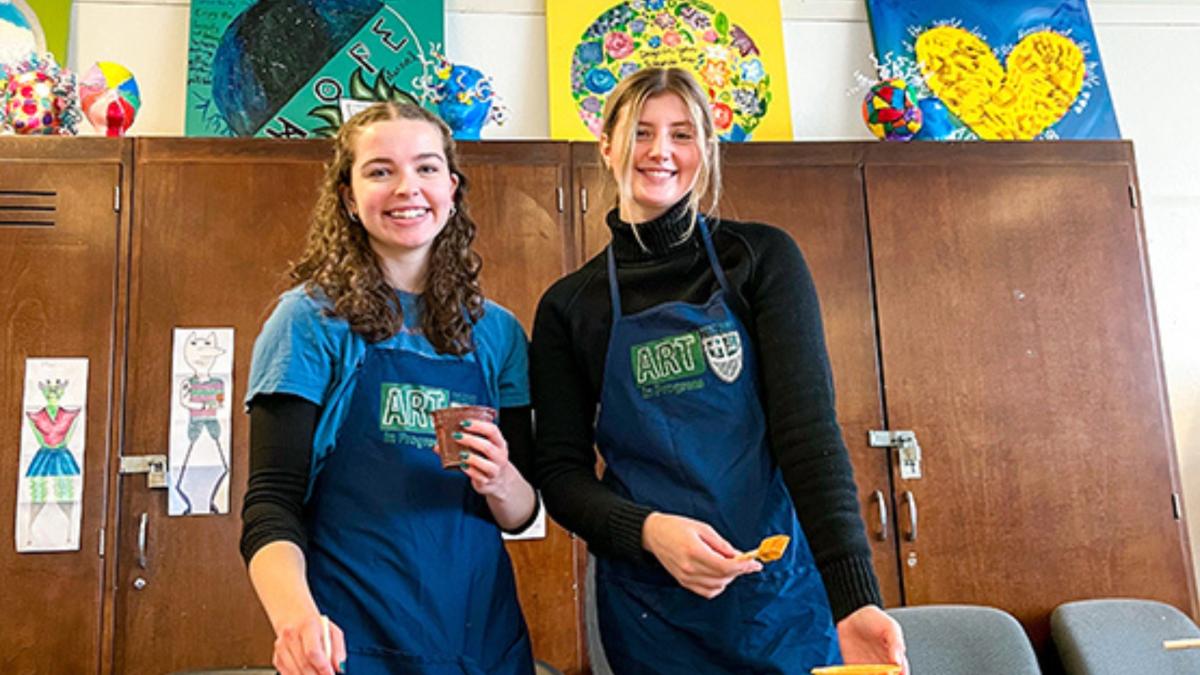
Heather Denning, M.A., LPAT, ATR-BC, ATCS, LSW
Chair, Department of Art, Design, and Communication
Director of Art Therapy
Office: Zurn 121A
Meet the Faculty
Art, Design, and Communication
